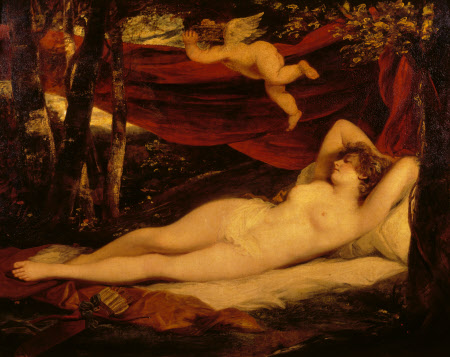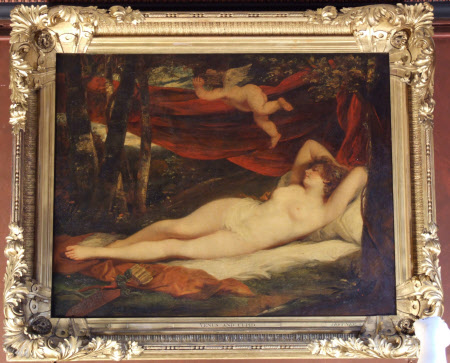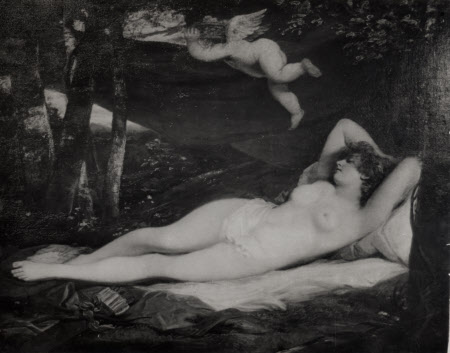Sleeping Nymph and Cupid
John Hoppner, RA (London 1758 – London 1810)
Category
Art / Oil paintings
Date
1806 (exh at RA)
Materials
Oil on canvas
Measurements
1320 x 1676 mm (52 x 66 in)
Place of origin
England
Order this imageCollection
Petworth House and Park, West Sussex
NT 486138
Caption
This picture was first exhibited in 1806 as ‘A Sleeping Nymph’, when the title was accompanied by six lines of verse. At one time the reclining nude was identified with Miss Emily St Clare, although this is questionable. A letter from Hoppner to Sir John Leicester (for whom this was painted) acknowledges the receipt of 170 guineas for a ‘Portrait of Miss St Clare’ and 300 guineas for ‘my picture of a Sleeping Nymph.’ Hoppner did do a subject picture of her, but as of a ‘Lady Dancing’ (now in the Nelson Atkins Museum of Art, Kansas City), in the guise of a muse. Originally the nymph was completely nude, but Sir John requested some covering. He wrote to Hoppner that ‘ … imagination must have something left to make the thing compleat …. To meet this idea Mr H will not perhaps object … to throw a veil over a part of ye Body.”
Summary
Oil painting on canvas, Sleeping Nymph and Cupid by John Hoppner, RA (London 1758 – London 1810), 1806. Nymph lying naked, with her head right and her arms above her head. Above her a red drapery for a canopy; Cupid can be seen flying over her. A forest glade setting. Hoppner believed this to be his masterpiece. A poem accompanied the painting when it was exhibited at the Royal Academy in 1806: "As on her arm reclines the sleeping fair, And with her breath the loitering gale perfumes, Love sees, or thinks he sees, his mother there, And nearer earth directs his glittering plumes; Hovers with fond delight around her bower, And swells the fragrance with a roseate shower." Sir George Beaumont (1753 - 1827), founder of the British Institution in 1805 and instigator of the foundation of the National Gallery in 1824, on reviewing the painting wrote: "... the best coloured picture that has been painted since Sir Joshua's death...In the white drapery He has discriminated as Sir Joshua did, & given effect to the flesh by the contrast but had almost confounded the colour of it with the flesh." It has been suggested it represents Sir John Leicester's mistress Miss Emily St Clare before he married Georgina Cottin in 1810. It was engraved in mezzotint by William Ward, ARA (1766-1826) and exhibited in 1808 when Sir John himself bought it, which gave rise to that supposition.
Provenance
Painted for Sir John Fleming Leicester, 5th Bt & 1st Baron de Tabley (1762-1827) in 1806 for 300 guineas and at Tabley Hall until 1810 when rolled up out of sight of his new wife; bought at his posthumous sale on 7 July 1827, lot 53 for £472.10s. by the 3rd Earl of Egremont (1751-1837); thence by descent, until the death in 1952 of the 3rd Lord Leconfield, who had given Petworth to the National Trust in 1947, and whose nephew and heir, John Wyndham, 6th Lord Leconfield and 1st Lord Egremont (1920-72) arranged for the acceptance of the major portion of the collections at Petworth in lieu of death duties (the first ever such arrangement) in 1956 by H.M.Treasury.
Credit line
Petworth, The Egremont Collection (National Trust)
Makers and roles
John Hoppner, RA (London 1758 – London 1810), artist
References
Carey 1819 William Carey, A Catalogue Anon: A Catalogue of Pictures by British Artists in the collection of Sir John Leicester, Bart, London, 1819, no.2, pp.4-10 Young 1821 John Young, A Catalogue of Pictures by British Artists in the possession of Sir John Fleming Leicester, Bart [...] including the pictures in his gallery at Tabley House, Cheshire [...], London, 1821, no.2, engraved. Farington 1804: Joseph Farington, The Diary of Joseph Farington, ed. Kenneth Garlick & Angus Macintyre, New Haven and London, 16 vols, 1978-84, 27 December 1810 McKay and Roberts 1909 William McKay and William Roberts, John Hoppner, R.A., 2 vols., London 1909-14, p.308 Collins Baker 1920 C.H.Collins Baker, Catalogue of the Petworth Collection of Pictures, in the possession of Lord Leconfield, privately printed by the Medici Society, London, 1920, 24, p. 59


